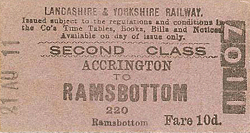 |
Notes: Accrington station was on the East Lancashire Railway’s (ELR) Clifton Junction to Accrington, Blackburn & Colne line at the point where the lines from Blackburn and from Burnley joined the line from Clifton Junction. The section of line on which Accrington stood was originally promoted by the Blackburn, Burnley, Accrington & Colne Extension |
Railway (BBACER), which was incorporated on 30th June1845. Three weeks later on 21st July 1845 BBACER was absorbed into the East Lancashire Railway (ELR).
Accrington station opened on 19th June 1848 when passenger services began between Blackburn and Accrington. The line from Stubbins Junction to Burnley opened on 17th August 1848, being extended to Colne from 1st February 1849.
Accrington station is close to the town centre. It was located on a triangle of lines but had platforms on only two sides of the triangle, the east side of which was the Clifton Junction - Burnley route and the north side the Blackburn – Burnley line. The west side of the triangle, without platforms, was used by trains travelling from the Clifton Junction direction to Blackburn. As all the |
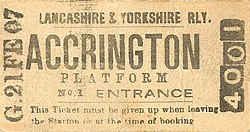
|
lines were double track there were two platforms for each of the lines, providing four through platform faces. The main entrance was east of the Clifton line, adjacent to the ‘up’ direction (Manchester) platform.
East Lancashire Railway built a 2-road locomotive shed in the triangle between the platforms at Accrington which opened with the railway. This first shed was closed by the Lancashire & Yorkshire Railway in 1873 and was immediately replaced with a 6-road shed on the Preston line west of Accrington station at Grimshaw Street. This closed in 1899 and was converted into a carriage shed in 1904 and was still standing in the 1960s. A third 8-road shed was opened in 1899 close to the second shed. This was reduced to 6-roads c.1937 and closed to steam on 6th March 1961 when it became a DMU depot. The shed was closed on 1st October 1972 and demolished within two years; much of site has now been redeveloped for housing.
 |
The 1849 timetable showed seven weekday trains from Accrington to Colne, and six to Manchester which originated at Colne. Four services ran to Colne on Sundays and three to Manchester from Colne. Other services ran westwards to Preston and eastwards to Burnley.
On 13th May 1859 the Lancashire & Yorkshire Railway (LYR) absorbed the ELR. By the 1890s Accrington had developed into a substantial junction station. The main entrance was a single-storey brick building at the end of a cab road which connected to the town centre. The main station building which housed the booking office gave access to platform 1 which served the ‘up’ line to Manchester. Platform 1 was also provided with other buildings which housed waiting rooms, a parcels office, toilets and numerous staff offices. A generous canopy ran for most of the length of the platform.
A roofed footbridge linked platform 1 to platforms 2, 3 and 4. Platform 2 and 3 made up a triangular island platform. Platform 2 served the ‘down’ Manchester line and was used by trains travelling towards Colne. Platform 3 served the ‘up’ Blackburn line. On the island platform there were four single storey brick built buildings that contained waiting rooms and toilets. Two of the buildings served platform 2 and two served platform 3. As with platform 1 a generous canopy was provided. Platform 4 had a long single-storey building containing waiting rooms and toilets |
and also had a canopy. To the west of the station between, and adjacent to, the triangle of lines, there were sidings and goods facilities. There was a large goods yard which included a goods shed, goods office, an 8-ton crane and the private Accrington Corporation siding. There was a further siding on the north side of the Burnley - Preston line serving cattle pens and a dock. There was a coal depot at Grimshaw Street adjacent to the motive power depot.
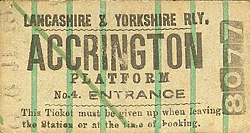
|
On 1st January 1922 Accrington station became part of the London & North Western Railway (LNWR) but a year later that company was in turn absorbed into the London Midland & Scottish Railway (LMS). By summer 1932 Accrington had thirty-nine eastbound services on weekdays; the majority went to Colne or Todmorden but there were also trains for Burnley, |
Ilkley, Rose Grove, Skipton and Wakefield. The first eastbound service was for Ilkley, and it left Accrington at 5:35 am. The last service which had originated from Manchester Victoria left Accrington for Colne at 11:30 pm.
Thirty-seven trains travelled west from Accrington. Most went either to Blackburn, Blackpool Central or Preston, but there were also trains to Fleetwood, Liverpool Exchange and Southport. The first westbound departure was for Preston and left Accrington at 6:00 am. The last train was for Blackburn departed at 11.30 pm. On Friday and Saturday evenings there was a train that left at 12:27am for Glasgow and Edinburgh.
There were eighteen southbound trains, most of which went to Manchester Victoria: the first left Accrington at 5:58 am and the last at 9:50 pm.
On 1st January 1948 Accrington became part of the nationalised British Railways (London Midland Region). Throughout the 1950s service patterns remained similar to LMS days and even as late as 1959 there were thirteen trains in each direction running between Colne and Manchester Victoria. Regular trains also connected Blackpool Central and |
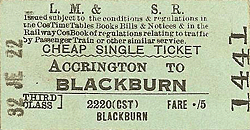 |
Burnley.
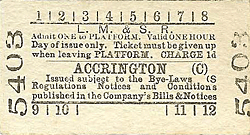 |
The purpose of The Reshaping of British Railways (Beeching Report) of March 1963 was to create an economically viable network, involving the closure of many loss-making passenger lines and stations. The report’s proposals for Lancashire were astonishing. The entire route from Manchester via Bury Bolton Street to Accrington was earmarked for closure. From |
1964 services between Manchester and Colne were rationalised and terminated at Accrington. On 14th September 1966 the Minister gave permission for the Stubbins Junction to Accrington line to close, which it did on 5th December 1966. The Grimshaw Street coal depot closed on 30th May 1966 and the goods facilities at Scaithcliffe Street were withdrawn on 4th December 1967 although a private siding remained open after this date.
A service through Accrington between Preston and Burnley continued to operate at about hourly intervals, which is still the frequency in 2010.
| Passenger trains ceased to serve platforms 1 and 2 but platform 1 continued to be used by parcels services. The line from Accrington to Stubbins Junction was lifted by 1971. At Accrington station a single track was left adjacent to platform 1 for the parcels trains. In the early 1970s the station’s canopies were removed. By April 1974 the line into platform 1 had been lifted. The |
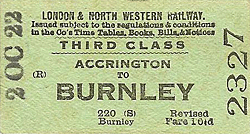 |
main entrance building was demolished and a small, modern brick building on the old platform 4 provided booking facilities. Platform 3 had only a ‘bus shelter’.
The Bury line platforms were still present until the mid 1980's when they were demolished to make way for a training centre and the St. Johns Ambulance building.
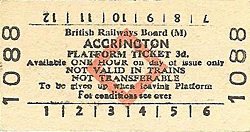 |
In October 2010 a new station building opened at Accrington. It is located on the trackbed of the Clifton line. Accrington ‘Eco station’ has been built as part of the SusStations Project and is the first Eco station on the Northern Rail network. The imaginative design is radically different from the bland 1960s booking office which it replaces. It is asymmetrical, featuring a curved |
roof supported on one side by canted pillars, and stone-clad, pent-roofed turrets rise above the roof level at each end. Beneath the booking area, in a ‘Learning Zone’, children can learn about the sustainability of the building. East Lancashire Community Rail Partnership commends the
Sustainable Stations (SusStations) project which aims to produce a new generation of sustainable, low carbon railway stations. Locally sourced materials, including recycled materials have been used in the construction of the building such as stone, and materials that can also be recycled if the building is dismantled in the future. Solar panels are installed and grey (rain) water is ‘harvested’ for use in the public and staff toilets. The station will be linked into other transport networks including pedestrian and cycle routes (such as the Hyndburn Greenway), the proposed new bus interchange and the local road network.
In 2010 Accrington was served by trains running between Blackpool South and Colne and between Blackpool North and Leeds.
Click here for Rory Lushman's account of Accrington station and engine shed.
See Railway Herald web site for more pictures of Accrington station in the 1960s
See also the Ramsbottom Model Railway Club web site which features 106 old photographs of the East Lancashire Railway and photographs of the clubs excellent layout of Ramsbottom & Stubbins.
Tickets from Michael Stewart , route map drawn by Alan Young, timetables from Chris Totty
Sources:
To see other stations on the East Lancashire Railway Clifton Junction - Bacup line click on the station name on the station name:
Clifton Junction, Molyneux Brow, Ringley Road, Radcliffe Bridge, Withens Lane, Bury Bolton Street, Summerseat, Ramsbottom, Helmshore, Haslingden & Baxenden
See also Stubbins Junction to Bacup: Stubbins, Irwell Vale (new station on the ELR), Ewood Bridge & Edenfield, Rawtenstall, Clough Fold, Waterfoot for Newchurch, Stacksteads & Bacup |

old1.jpg)

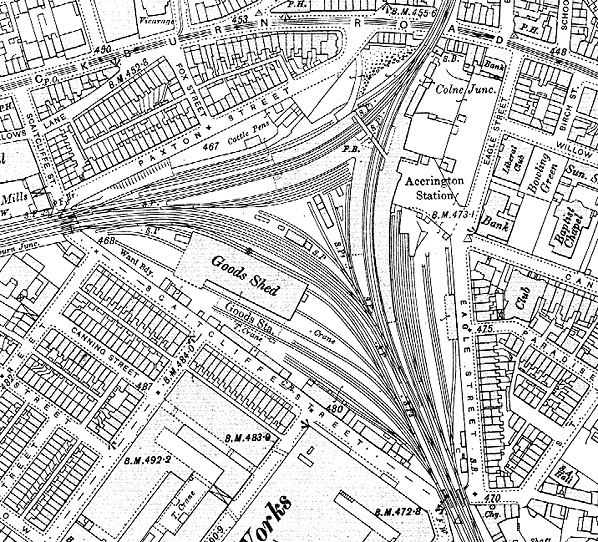
old3.jpg)
old12.jpg)
old4.jpg)
old5.jpg)
old13.jpg)
1.jpg)
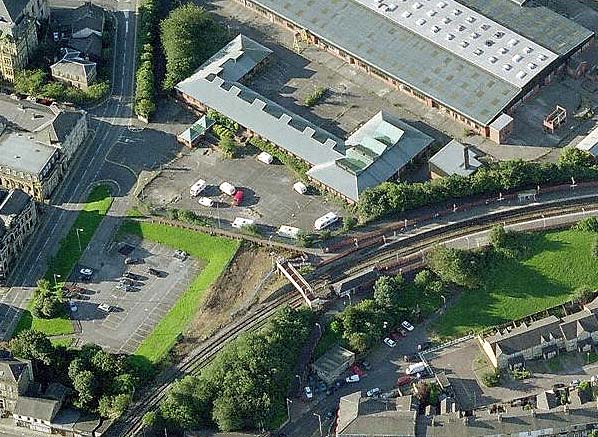
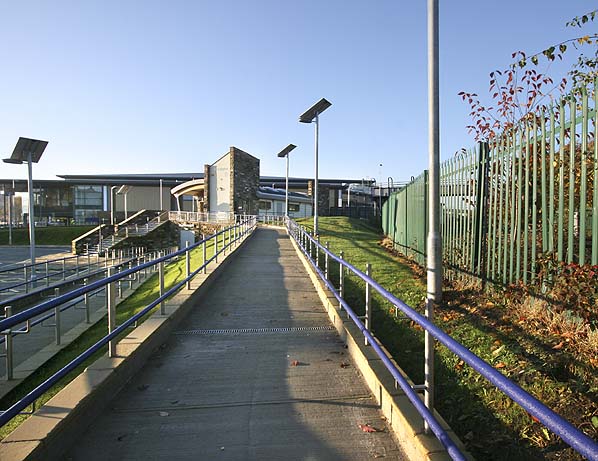 Looking southwest from the junction between the Clifton Junction line and the Preston to Burnley line. To the right beyond the fence the latter line, which is still open to passengers, can be seen. The new Accrington station building opened in October 2010, seen towards the left, sits across the trackbed of the former line to Manchester via Clifton Junction.
Looking southwest from the junction between the Clifton Junction line and the Preston to Burnley line. To the right beyond the fence the latter line, which is still open to passengers, can be seen. The new Accrington station building opened in October 2010, seen towards the left, sits across the trackbed of the former line to Manchester via Clifton Junction.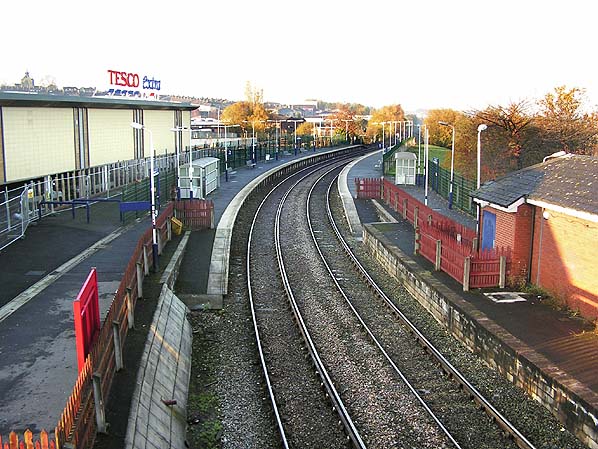





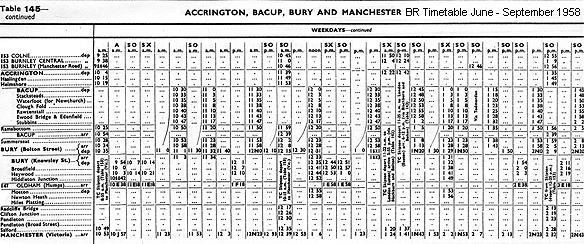



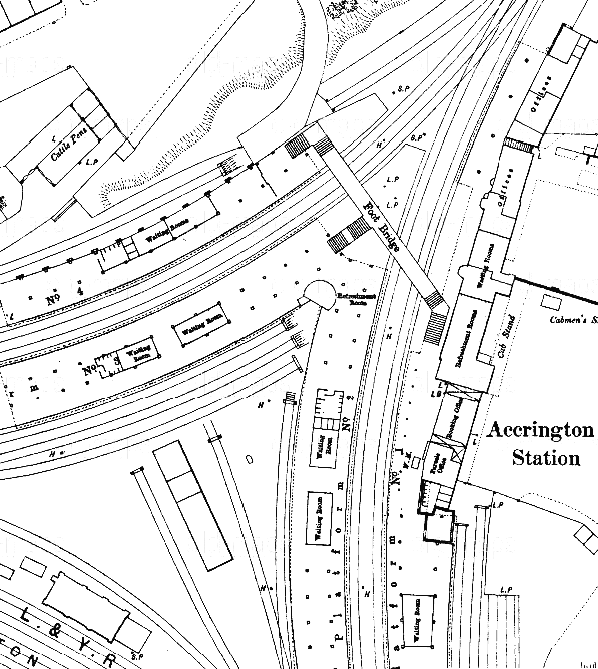
old_thumb15.jpg)
old_thumb10.jpg)
old_thumb11.jpg)
old_thumb2.jpg)
old_thumb9.jpg)
old_thumb6.jpg)
old_thumb11.jpg)
old_thumb7.jpg)
old_thumb8.jpg)
old_thumb14.jpg)
thumb2.jpg)
thumb3.jpg)
thumb4.jpg)





 Home Page
Home Page